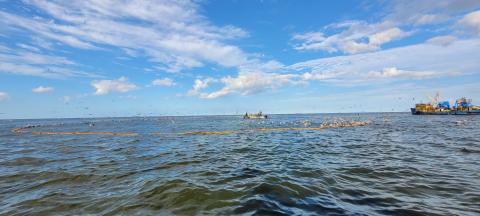The Open Ocean Trustee Implementation Group, in partnership with the Gulf of Mexico Menhaden Fishery, has completed a project assessing methods for observing sea turtle interactions during fishing operations and determined that electronic monitoring proved most effective.
The goals of the Developing Methods to Observe Sea Turtle Interactions in the Gulf of Mexico Menhaden Purse Seine Fishery Project (Menhaden Project) were to test methods to observe the Gulf of Mexico Menhaden Fishery, collect data on the nature and extent of interactions with sea turtles, and identify ways to work with industry partners to establish voluntary measures to avoid and reduce interactions in the future. After testing a range of observation methods during the 2022 and 2023 fishing seasons, the project has completed implementation.
As the Trustees restore sea turtle species injured by the 2010 Deepwater Horizon oil spill, they have worked closely with both commercial and recreational fisheries. In the case of the Menhaden Project, collaboration with the fishing industry at every stage of the project was critical for its success. Members of the menhaden fishery joined a steering committee with NOAA project managers and species experts to provide input on planning, objectives, and feedback. Also interested in the success of this project, industry members provided their vessel to conduct proof of concept field tests .
The purse seine menhaden fishery targets the small, but economically important menhaden, used as an ingredient in pet food, aquaculture, and livestock feeds, as well as fertilizers and commercial fishing bait. Other fish and animals, like sea turtles, can be incidentally caught and entrapped in the purse seine nets as they’re hauled in, potentially causing injuries or death.
To determine the most effective method of fishery observation, the project team used three methodologies, alongside or onboard fishery vessels, between 2021 and 2023:
• Drones—aerial monitoring of vessels
• Human observers–biologists onboard non-fishing vessels documenting interactions
• Electronic monitoring–stationary video cameras installed on fishing vessels
During a seven-day test phase, the team determined that human observers and electronic monitoring were the only two that should move forward to a full pilot phase. Further use of drones was dismissed due to cost and battery life. After the first year of pilot testing, the team agreed to stop using human observers during the second year of the pilot due to limited field of view from their vantage point outside the net.
More on each method’s benefits and limitations can be found in the Pilot Phase Year 1 & 2 Summary Report (PDF, 44 pages). Additionally, the February 2024 Executive Summary (PDF, 20 pages) report provides a high-level overview of the Menhaden Project’s outcomes and recommended actions to further reduce interactions.
By collaborating with fishing industry partners, the project team was able to compare observation methods by examining approximately 10-20% of the industry’s overall yearly fishing effort across two years (2022 and 2023). Through this project, electronic monitoring was determined to be the most effective and efficient way to observe sea turtle interactions in the net during fishing operations.
The Menhaden Project was approved by the Deepwater Horizon Oil Spill Open Ocean Restoration Plan 2 in 2019.
Get future updates delivered directly to your inbox. Subscribe today for Gulf Spill Restoration news and updates.


